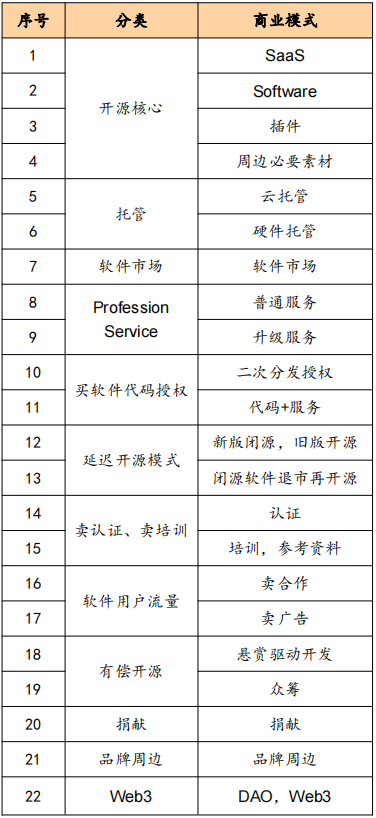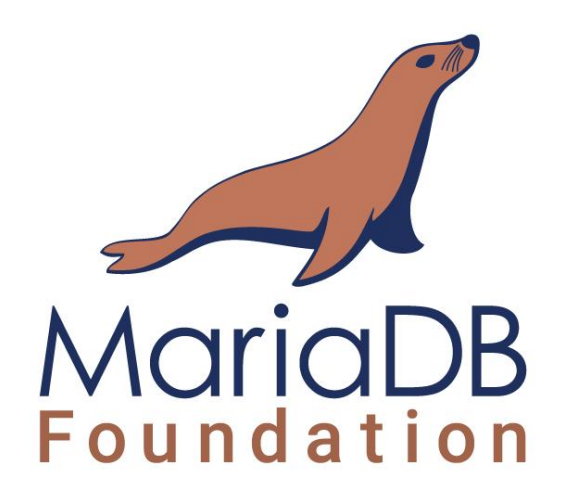Author: Guo Wei (Guo Daxia)
In recent years, open source has become an increasingly popular topic around the world, and more and more open source projects have received a lot of investment or are eventually listed. Open source is a development model that discloses code on the Internet according to some open source protocols and has open source communities and users. So open source project code is open, and how can a closed commercial loop be formed to form commercial income?
The author refers to many paper websites and company materials around the world, and finally summarizes the business models of most open source projects in the world to generate income, a total of 22 types. If you are an open source enthusiast or have your own open source project, you can get from these open source commercial companies. find some inspiration in the business model.I also established an open source project for this purpose. At the end of the article, if there is any missing or inaccurate place, you are welcome to leave it directly in the project.issueOr give a PR.

- Core open source, non-core closed source
First of all, the most common is the business model that the core code of the software is open source, and the non-core part is closed source, so as to charge in various forms. There are 4 sub-categories of this revenue model:
The first type of charging model is the open source commercial SaaS model, that is, the core code is open source, but the code behind the commercial SaaS cloud service is closed source, and some of its functions are not available in the open source version. A typical example is the familiar Databricks. Its open-source Apache Spark is open-sourced under the Apache protocol, but Databricks’ cloud service is closed-source, and its performance and functions far exceed its open-source Spark version.
Category 2 isopen-core business software model, that is, the core code is open source, but some functional codes are closed source, and finally closed source code software is formed for sale. For example, Cloudera Data Platform sold by Cloudera, which supports open source Apache Hadoop, is the representative of this software model. Of course, with the development of cloudification, these commercial companies that initially sell software now also provide their own cloud versions. But there are still many common open source software sold using this model.
The third category is the Plug-in charging model. The software itself is open source, but the plug-ins on it are paid, and these plug-ins can help the software to be faster.landIn the industry to improve its use efficiency or complete specific target functions, some CAD open source software companies use this business model.
The fourth category is the material charging mode, that is, the software itself is open source, but it is running or usingTimeNeed related materials,And these materialsis required to purchase. This kind of business model is more common in game engines, because the engine itself is only a computing core, and the surrounding materials can be used to quickly develop related games. Examples of this business model are engines such as Arx Fatalis, Catacomb 3-D, etc. .
The four categories described above are actually open source core codes, but some of the surrounding capabilities are models that require fees.
The fifth type is our common cloud hosting model. Its code is almost the same as that of open source projects, with only slight differences in cloud accounts and related services.no needYou can install the open source software yourself, and you don’t need to hire relevant personnel to maintain the open source software. You can directly use the relevant services. The typical one is MongoD.Bhosting services provided by Elastic.
The sixth is an all-in-one model that integrates hardware and open-source software. For example, in the past, Sun Corporation bundled open-source Solaris on its own server for sale, and the end user did not need to install the software for debugging or adaptation. Directly use the relevant open source software provided by the hardware provider.
The above two core business models are actually business models that help companies save installation and commissioning and some operation and maintenance costs.
This is a more ambitious ecological business model.
Type 7YesSoftware market (marketplace), this business model generally appears in the operating system or basic software with a large number of users. For example, Android, Mozilla’s Firefox, they have a huge user base. At the same time, many people will develop free software or plug-ins based on this software environment.whenUser buys hisThesesoftwareTime,The company realizes its income by collecting a middle commission.
The eighth is to provide ordinary operation and maintenance and Q&A services (Professional Service). For example, HDP and Redhat of Hortonworks (before it was acquired by Cloudera) are this model. Its software code is the same set of code as open source, and enterprises need to pay support and consulting fees to ensure that these software work properly.
The ninth type is that the software itself is open source, and income is generated by charging for upgrade services. This kind of general software itself is very easy to use, but its own data is very important. During each upgrade process, in order to ensure the integrity of the enterprise data and the stability of the software after the upgrade, the user will purchase the upgrade service from the professional open source original company. .
The tenth is to sell the secondary distribution authorization of soft open source software for income, such as the familiarmacThe OS is developed based on the exclusive rights of the BSD Unix operating system kernel, so BSD Linux relies on this authorization to obtain income.

The 11th is to sell the same open source code software and provide related services toconductincome. For example, ardour and radium, they sell the same binary code of open source software and related services for income. Generally, there are mostly small software in this model.
Depend oncommercial softwaregetOpen source model after income. In this way, the commercial revenue of the latest version can be guaranteed, and the vitality of the open source community can be guaranteed at the same time.
The 12th open source business model is the delayed open source model, that is, the new closed source model and the old version open source model, a typical one is MariaDB Corporation. Its new versions are all commercial versions, but when he develops an updated commercial version, his original commercial version will be open sourced for everyone to use.

The 13th type is called delisting and open source. This model is that commercial software has basically completed its commercial life cycle, and it will be open sourced when it is delisted. A lot of game software is actually this mode, so we can see that many MOD game modes are developed based on such delisted game software, the more typical game software related to id Software and 3D Realms.
14. Open SourceBusinessThe model is to sell authentication.The software itself is open source,but it providesbased on the softwarerelated content or related servicesto charge,Because it is the initiator of software and patterns. Therefore, it can earn income through a certified model.The system certified by him will be more authoritative, and usersCanmore assuredlandPurchase, such as early Unix v3 v8 certification, and the current Moodle mode.
The 15th open source business model is to sell training and related reference materials. The open source software itself is not necessarily established by the company, but it can sell related training and publishing related materials for income. For example, O’Reilly Publishing Company is based onsellFamous for open source books.
- Leverage the user traffic of the open source community
The 16th is to run open source community collaborations for revenue. For example, the more famous Google’s Open Source Summer (GSoC), its revenue model is to help various communities organize developer business activities to achieve departmental revenue.
The 17th is to earn fees for selling traffic on open source software.The software itself is open source,usermore traffic, the software uses the traffic to generate revenue. This is the case with the most popular AdBlock Plus in Google’s chrome plug-in. Every year, Google pays a lot of fees to keep him from blocking ads from Google. AdBlock Plus makes money from it.
Both of the following are ways for companies or individuals involved in open source projects to generate income.
The 18th type is called open source reward, that is, reward related tasks in the open source community, and finally developers complete the related tasks. Get relevant rewards and ultimately achieve personal and company income. For example, Mozilla once offered a reward to volunteers or companies to solve its security risks and then paid the relevant fees.
The 19th is called crowdfunding.That is, an open source project that willrighthis userconductPre-sale,plan for a certain amountafter thatHire open source developers to complete the project,andopen sourceputCome out, for example, OpenGL 4.3 extension for the Mesa librar is an open source project developed in this mode.
The following two open source are more Buddhist. Do not rely on the software itself to make money, but rely on peripherals and donations to obtain income maintenance.
The 20th is to accept donations for income. For example, the Mozilla Foundation receives a large amount of donations from Google every year to maintain the operation of the entire Mozilla Foundation. Similarly, VUE made by Chinese developer You Yuxi in China has also received a lot of donations from various companies.
The 21st is to sell brand peripherals for income, such as Mozilla Foundation andThe Wikimedia Foundation has related sentimental T-shirts or mugs.The Frisbee, stickers, cups, and hats in the recent Apache Con Aisa individual tickets are actually sold aroundgetincome.
No. 22kind,Toothe last,YesI am very optimistic about the open source revenue model that is still in the development process, which is Web3 to Developer.The open source community itself is a DAO, but the current open source is still difficult to obtain by measuring individual contributionsincome.It is also difficult for open source software to become an NFT-like organizationgetincome and profit.But I think that with the development of DAO theory and the progress of related technologies, related problems will be solved, so that every open source contributor can truly get what he earns, every open source company contributes something, and every investor invests in return. , which is the ultimate solution for the open source community.
To sum up, it took me a long time to sort out a variety of open source to commercial gameplay, and I also built an open source commercial project on Gitee,And open source this article and table, you are welcome to comment in it orPRor mentionissue to contribute and work together to maximize the commercialization of the open source community, thank you all.
project address:
https://gitee.com/William-GuoWei/OpenSource_BusinessModel
About the Author:Guo Wei (Guo Daxia) is a member of the Apache Foundation and an Apache incubatorInstructor, Founder of ClickHouse Chinese Community, Apache Dolphin Scheduler PMC, Apache SeaTunnel (incubating) guideTeacher, the best 33 people in China’s open source community, China’s 2021 open source outstanding peoplething.
WeChat public account: Guo Daxia said open source
Guo Daxia, a technical hacker who loves open source, shared his insights into global open source
Business models and the latest open source community discussions.
This article comes from the fourth issue of the open source collection “Open Source Viewing”. For more exciting content, please click to download:
https://oscimg.oschina.net/public_shard/opensource-guanzhi-20220915.pdf
#complete #open #source #business #revenue #models #world
